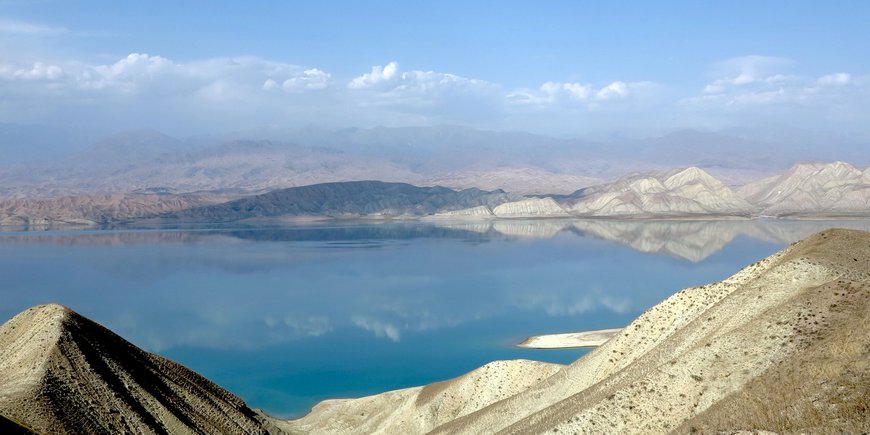Speleothems and monitoring
Changes in Central Asia precipitation patterns and temperatures have a direct impact on water resources. The region around the Fergana Valley in particular is highly sensitive to climate threats from drought and floods.
Speleothems (dripstones) from caves form excellent terrestrial archives for palaeoclimatological studies. They can be dated very precisely using the U/Th or 14C method and contain a large number of environmentally dependent proxies. The climate variability and hydrological changes in the past can be reconstructed using stable isotopes (δ13C, δ18O) and trace elements.
The basis for these investigations is the understanding of the isotopes of the recent precipitation pattern as well as their input into the caves. For this purpose, we installed a network of precipitation collectors in Kyrgyzstan and use logger in suitable caves for continuous measurement of temperature and humidity.
Partners
Alexej Dudashvili (Foundation for Preservation and Exploration of Caves in Kyrgyzstan)
Hai Cheng (University Minnesota, Xi'an Jiaotong University)
Jens Fohlmeister
References
Fohlmeister, J., Plessen, B., Dudashvili, A. S., Tjallingii, R., Wolff, C., Gafurov, A., Cheng, H. (2017): Winter precipitation changes during the Medieval Climate Anomaly and the Little Ice Age in arid Central Asia. - Quaternary Science Reviews, 178, 24-36. https://doi.org/10.1016/j.quascirev.2017.10.026
Plessen, B., Helle, G. (2017): Vom Monitoring zum Klimaarchiv: Sauerstoffisotope in der Paläoklimatologie. - System Erde, 7, 1, 12-19. https://doi.org/10.2312/GFZ.syserde.07.01.2
Schwarz, A., Turner, F., Lauterbach, S., Plessen, B., Krahn, K. J., Glodniok, S., Mischke, S., Stebich, M., Witt, R., Mingram, J., Schwalb, A. (2017): Mid- to late Holocene climate-driven regime shifts inferred from diatom, ostracod and stable isotope records from Lake Son Kol (Central Tian Shan, Kyrgyzstan). - Quaternary Science Reviews, 177, 340-356. https://doi.org/10.1016/j.quascirev.2017.10.009
Wolff, C., Plessen, B., Dudashvilli, A. S., Breitenbach, S. F., Cheng, H., Edwards, L. R., Strecker, M. R. (2017): Precipitation evolution of Central Asia during the last 5000 years. - Holocene, 27, 1, 142-154. https://doi.org/10.1177/0959683616652711
References (Central Asia)
Zhang, W., Mischke, S., Hosner, D., Zhang, C., Plessen, B., Li, H., Zhang, X. (2023): Late glacial and Holocene climate in the Kunlun Pass region (northern Tibetan Plateau) inferred from a multi-proxy lake record. - Quaternary International, 643, 46-60. https://doi.org/10.1016/j.quaint.2022.10.013
Börner, N., Jochum, K. P., Stuhr, M., Abstein, M., Plessen, B., Frenzel, P., Wang, J., Zhu, L., Schwalb, A. (2022): Late Quaternary changes in moisture availability and weathering intensity on the central Tibetan Plateau indicated by chemical signatures of ostracod shells. - Frontiers in Earth Science, 10, 826143. https://doi.org/10.3389/feart.2022.826143
Struck, J., Bliedtner, M., Strobel, P., Taylor, W., Biskop, S., Plessen, B., Klaes, B., Bittner, L., Jamsranjav, B., Salazar, G., Szidat, S., Brenning, A., Bazarradnaa, E., Glaser, B., Zech, M., Zech, R. (2022): Central Mongolian lake sediments reveal new insights on climate change and equestrian empires in the Eastern Steppes. - Scientific Reports, 12, 2829. https://doi.org/10.1038/s41598-022-06659-w
Kasper, T., Wang, J., Schwalb, A., Daut, G., Plessen, B., Zhu, L., Mäusbacher, R., Haberzettl, T. (2021): Precipitation dynamics on the Tibetan Plateau during the Late Quaternary – Hydroclimatic sedimentary proxies versus lake level variability. - Global and Planetary Change, 205, 103594. https://doi.org/10.1016/j.gloplacha.2021.103594
Mischke, S., Zhang, C., Plessen, B. (2020): Lake Balkhash (Kazakhstan): Recent human impact and natural variability in the last 2900 years. - Journal of Great Lakes Research, 46, 2, 267-276. https://doi.org/10.1016/j.jglr.2020.01.008
Mischke, S., Zhang, C., Liu, C., Zhang, J., Jiao, P., Plessen, B. (2019): The Holocene salinity history of Lake Lop Nur (Tarim Basin, NW China) inferred from ostracods, foraminifera, ooids and stable isotope data. - Global and Planetary Change, 175, 1-12. https://doi.org/10.1016/j.gloplacha.2019.01.017
Tarasov, P. E., Ilyashuk, B. P., Leipe, C., Müller, S., Plessen, B., Hoelzmann, P., Kostrova, S. S., Bezrukova, E. V., Meyer, H. (2019): Insight into the Last Glacial Maximum climate and environments of the Baikal region. - Boreas, 48, 2, 488-506. https://doi.org/10.1111/bor.12330
Alivernini, M., Akita, L. G., Ahlborn, M., Börner, N., Haberzettl, T., Kasper, T., Plessen, B., Peng, P., Schwalb, A., Wang, J., Frenzel, P. (2018): Ostracod-based reconstruction of Late Quaternary lake level changes within the Tangra Yumco lake system (southern Tibetan Plateau). - Journal of Quaternary Science, 33, 6, 713-720. https://doi.org/10.1002/jqs.3047
Heinecke, L., Epp, L. S., Reschke, M., Stoof-Leichsenring, K. R., Mischke, S., Plessen, B., Herzschuh, U. (2017): Aquatic macrophyte dynamics in Lake Karakul (Eastern Pamir) over the last 29 cal ka revealed by sedimentary ancient DNA and geochemical analyses of macrofossil remains. - Journal of Paleolimnology, 58, 3, 403-417. https://doi.org/10.1007/s10933-017-9986-7
Heinecke, L., Mischke, S., Adler, K., Barth, A., Biskaborn, B. K., Plessen, B., Nitze, I., Kuhn, G., Rajabov, I., Herzschuh, U. (2017): Climatic and limnological changes at Lake Karakul (Tajikistan) during the last ~29 cal ka. - Journal of Paleolimnology, 58, 3, 317-334. https://doi.org/10.1007/s10933-017-9980-0
Mischke, S., Liu, C., Zhang, J., Zhang, C., Zhang, H., Jiao, P., Plessen, B. (2017): The world’s earliest Aral-Sea type disaster: the decline of the Loulan Kingdom in the Tarim Basin. - Scientific Reports, 7, 43102. https://doi.org/10.1038/srep43102









